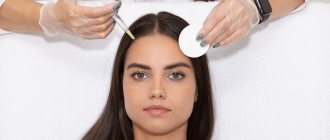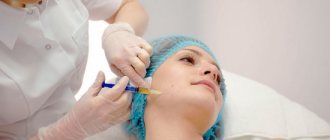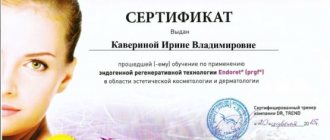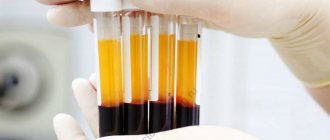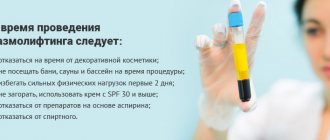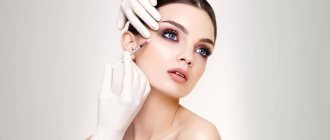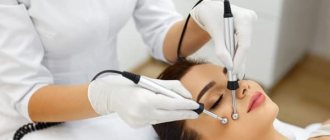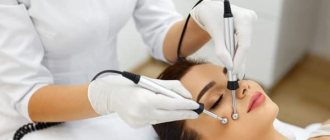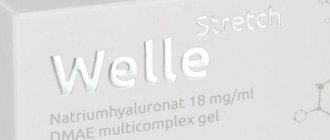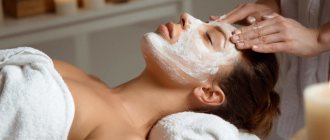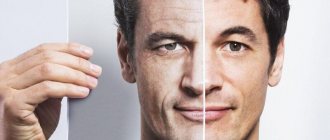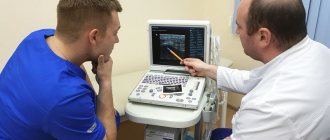Author
Oreshnikova Maria Vladimirovna
Leading doctor
Dermatologist
until December 31
Appointment with a cosmetologist for 1 rub. when paying for cosmetology services on the day of treatment More details All promotions
Plasmolifting
is a modern cosmetological technique with which the effect of skin rejuvenation is achieved through injections of the patient’s own plasma. Plasma is the liquid part of blood. Using your own plasma eliminates incompatibility problems and minimizes the risk of allergic reactions.
Plasmolifting: the essence of the method
Plasmolifting stimulates natural regeneration processes in problem tissues. This is achieved by injecting platelet-rich plasma into them. Platelets ensure blood clotting; this is their main function. However, scientists later discovered that platelets also have another function: they not only participate in the creation of blood clots (thrombi) that prevent bleeding, but also produce substances that promote the healing of damaged tissue. It is this property of platelets that allows one to obtain a therapeutic effect from the plasma lifting procedure.
Plasmolifting accelerates regeneration processes (restoration of lost tissue structure). After the plasma lifting procedure, the skin tightens, its hydration and elasticity increase.
Preparation for the procedure
Your doctor will tell you in detail how to prepare for facial plasma lifting during your preliminary consultation. Typically, it is advisable to adhere to the diet and restrictions 2–3 days before the scheduled procedure.
Basic recommendations before facial plasma lifting:
• Eliminate heavy, fatty, salty, spicy foods from the diet. It is recommended to enrich the menu with healthy foods rich in vitamins, micro- and macroelements. These include: fresh fruits, vegetables, berries, herbs, lean meat, fish, dairy products, whole grain cereals. The diet before facial plasma lifting should be balanced according to BJU. • Establish a drinking regime. During the day, it is advisable to drink 1.5 - 2 liters of regular table water without gas. You should avoid strong coffee and tea. • Reduce the intensity of physical activity. • Have a good rest and sleep.
What not to do before facial plasma lifting:
• drink alcohol and smoke; • carry out cosmetic procedures that involve trauma to the skin; • take drugs from the group of anticoagulants (blood thinners); • sunbathing.
During the consultation, many patients are concerned with the question: is it possible to eat before plasma lifting of the face? If the manipulations are scheduled for the morning, it is advisable to refrain from eating and organize dinner 8–12 hours in advance. If the procedure is planned to be carried out in the afternoon, then it is advisable to organize the last meal 2 – 3 hours in advance. Doctors advise choosing light, healthy, nutritious meals.
How is plasma lifting performed?
Plasmolifting in the clinics of JSC Family Doctor
The procedure consists of several stages. First, blood is drawn from the patient. Blood is taken from a vein in an amount of 9 to 36 ml. The platelet-rich plasma is then separated using a special centrifuge. Finally, the rejuvenation procedure itself is carried out: using injections, the resulting plasma is injected into problem areas of the skin. The injection technique is similar to conventional mesotherapy. The total procedure time is approximately 1 hour.
The course consists of 2-4 procedures. The interval between procedures is 2-3 weeks.
Plasmolifting can be used to eliminate skin problems in any area, including the face, neck, décolleté, scalp, etc. In order to undergo the plasma lifting procedure, you need to make an appointment with a cosmetologist.
Indications and contraindications
Plasma therapy is recommended for patients with the following facial skin problems:
• decrease in tightness, elasticity, firmness; • signs of photoaging; • wrinkles, folds, creases; • hyperpigmentation; • acne of varying severity; • peeling, excessive dryness; • scars, scars, post-acne; • unhealthy color; • bags and dark circles under the eyes; • enlarged pores. Conditions and diseases for which it is contraindicated to resort to the • technique: pregnancy, breastfeeding; • malignant and benign formations in the affected area; • oncological processes of various localizations; • autoimmune pathologies; • acute viral or infectious diseases; • chronic pathologies in the acute stage; • damage to the integrity of the skin in the area of intended treatment; • severe form of arterial hypertension; • decompensated diabetes mellitus; • diseases of the hematopoietic system; • severe mental disorders, central nervous system diseases; • hormonal and endocrine disorders.; • allergy to anticoagulants; • critical days.
Biorevitalization or plasmolifting: Which is better?
Biorevitalization and plasmolifting are two injection cosmetic procedures that are aimed at rejuvenating facial skin and combating age-related changes.
These methods are used in aesthetic cosmetology clinics to eliminate deep wrinkles on the face in the area of the eyelids, forehead and nasolabial folds, as well as to combat low turgor and dry skin. Biorevitalization together with plasmolifting can also be performed as an additional procedure for accelerated recovery after chemical peeling or laser rejuvenation. These two methods are similar to each other and can even complement each other to achieve better results. But what are the differences between them? What is better to choose: biorevitalization or plasma lifting? Let's take a closer look at each of the cosmetic facial procedures so that you can make your choice.
Advantages of hardware procedures
Thus, thanks to hardware effects, it is possible to stimulate the natural reserves of the skin. Laser, photo or RF exposure improves the functioning of fibroblasts - the main skin cells that synthesize collagen, elastin and hyaluronic acid molecules. As a result, the skin becomes denser, more elastic, and tightened. Hardware techniques help achieve a lifting effect, smooth out fine wrinkles and make deeper ones less noticeable, remove age spots and spider veins.
As a rule, hardware procedures have a cumulative effect. Simply put, immediately after the procedure you will already be able to see the first effect of rejuvenation. But it will reach its maximum gradually. In a few weeks, your face will be completely transformed.
Gutsenko Liliya Anatolevna
Cosmetologist
FAQ:
- Could plasma injections trigger the growth of cancer cells?
No, because the growth factors contained in platelets do not have oncogenic properties and, therefore, cannot cause cell mutation.
- At what age is plasma treatment allowed?
From the age of 15.
- What determines the cost of the procedure? They say that the cost of plasma lifting does not exceed 300 rubles?
There are many components included in the price, the most significant of which is intellectual property.
- If plasma lifting is performed on a patient with hepatitis, syphilis or HIV, what will be the consequences?
This will not cause any problems, but patients with such diseases are excluded from the procedure group.
- What tests need to be done before the procedures?
The so-called small preoperative list includes: clinical and biochemical blood tests, as well as analysis for markers of HIV, hepatitis and other infectious diseases.
- Are there any contraindications to this technique?
Yes. These include all severe and systemic diseases. You can learn more about contraindications during your consultation.
- Is one procedure enough to get results?
40% of patients report a positive effect after the first procedure. Repeated sessions strengthen it. The full course usually consists of 4 procedures.
- How often should treatment courses be repeated?
It depends on individual characteristics. Typically, 2 courses per year are required to achieve maximum results. The effect of treatment can last up to two years.
- Is it possible to deplete the body's resources with plasma lifting?
No, that's impossible.
- Is the procedure performed on an empty stomach?
Yes, it is desirable.
- Is pain relief given before procedures?
This is only necessary if the patient is hypersensitive. Usually no anesthesia is required.
- Why are pregnancy and breastfeeding contraindications for plasma injection?
In order not to violate the principle of non-interference in these processes.
- Is the result guaranteed when using this technique?
As with any other treatment method, it is difficult to talk about guarantees. But the efficiency is from 60 to 80%. To get a lasting result, you need to complete a full course consisting of four procedures.
- Do plasma injections leave bruises?
It happens sometimes. As with mesotherapy.
- Is it possible to take a plasma lifting course in the summer?
Summer time is exactly recommended for procedures. During this period, the skin is exposed to intense sun exposure, which creates the risk of burns and can lead to the appearance of age spots. A course of plasma lifting
, both before and after the holiday, effectively combats these phenomena and also prevents photoaging.
- Do I need to do facial cleansing before procedures?
Not necessary.
- Is it possible to perform plasma lifting not only of the face, but also of eyelashes and hair in one procedure?
Can.
- Is it true that PLASMOLIFTING tm can completely cure baldness, regardless of its causes?
This technique is one of the most effective in the world for treating hair loss. There are no alternatives to it in this area. And although it does not provide a 100% guarantee, we can confidently say that the method is effective in 60-80% of cases.
- Is it true that the method will not help those who have deep wrinkles? Is there an age limit for the effectiveness of plasma lifting?
Yes, it's 75 years. It is not true that the method is ineffective for severe wrinkles and soft tissue atrophy. It’s just that in more complex cases a course of not 4, but 6 procedures is required.
- How many procedures do you need to do to stop hair loss completely?
Two is enough.
- Is it possible to get rid of facial wrinkles using plasma injections?
After the procedures, small wrinkles (for example, in the form of a mesh around the eyes) should be smoothed out.
- Can plasma lifting be called an alternative to biorevitalization? Which of the two methods is better?
You can call it an alternative. I think that plasma lifting is better because it is more natural.
- How long does it take for eyelashes to grow?
From two to three months.
Water treatments
There is a constant flow of people in the pool, sauna or bathhouse. Even when the body is in a less vulnerable state than after plasma lifting, in such places there is a risk of becoming infected with easily transmitted diseases - for example, fungus. Bacteria will freely penetrate the skin damaged by microneedles. In addition, chlorine and other cleaning agents that are always present in public pool water can cause an allergic reaction.
Unusually high temperature is the main feature of baths and saunas, and it is dangerous for the patient after exposure to plasma. Warm wounds heal more slowly, making infection even more likely.
It is not recommended to visit all of the listed establishments during the entire plasma lifting course.
Makeup
After a plasma lifting session, you will have to give up decorative cosmetics for a while. During the procedure, microscopic needles injure the skin, piercing it and leaving wounds invisible to the eye. The entry of bacteria contained in any makeup products into these wounds can cause inflammation, acne and ulcers. Some components of decorative products cause an allergic reaction when they get into small punctures on the face.
Plasma therapy specialists do not recommend using creams, scrubs and lotions for washing until three days have passed since the session.
Combined use of the PLASMOLIFTING TM method with injection and hardware correction methods
R. Akhmerov, Doctor of Medical Sciences, Professor, General Director of the Clinic,
R. Zarudiy, Candidate of Medical Sciences, maxillofacial surgeon, implantologist,
O. Korotkova, dermatocosmetologist,
A. Altyeva, Candidate of Medical Sciences, maxillofacial surgeon, plastic surgeon,
E. Kumukova, dermato-oncologist, Moscow, Russia
Essay
Options for combining the PlasmoliftingTM method with other anti-aging procedures in comprehensive care programs for aging skin are presented. The use of the PlasmoliftingTM method allows you to achieve the best results, reduce the recovery time after traumatic skin procedures, and stimulate the skin cells’ own regenerative response. Various techniques for injecting platelet-rich plasma into the skin have been demonstrated.
1. INTRODUCTION
The problem of treating age-related changes in the face remains one of the main ones in dermatocosmetology. The main causes of age-related skin changes are a violation of antioxidant protection, thinning of capillary walls, a decrease in the amount of hyaluronic acid, and a violation of melanogenesis. As a result, the skin loses its firmness and elasticity, and wrinkles and folds form.
Cosmetic procedures are aimed at preventing and restoring the effects of various temporary and external aging factors. But unfortunately, it is not possible to achieve an ideal result with a prolonged effect using individual procedures.
Therefore, the choice of a dermatocosmetologist is comprehensive care programs that combine in various combinations methods such as botulinum therapy, contour plastic surgery, biorevitalization, plasma lifting ( PlasmoliftingTM ) , mesotherapy, chemical peels, intralipotherapy, thread lifting, and various hardware methods.
2. PLASMOLIFTINGTM IN COMPLEX CARE PROGRAMS FOR AGING SKIN
Plasmolifting is a universal method of tissue stimulation, which consists of local injection of platelet-rich autoplasma (PRP).
It is not entirely clear by what mechanisms the regenerative effect of platelet-rich plasma occurs; most likely, the main role here is played by growth factors contained in platelets. However, other hypotheses cannot be ignored: cytokine, nutrient, hormonal, environmental.
Due to its biological properties and the resulting clinical effects, plasmolifting can be considered a basic procedure in the practice of a modern dermatocosmetologist.
After the procedure for administering PRP, there is a smoothing of fine wrinkles, a decrease in the depth of deep wrinkles, nasolabial folds, an increase in skin elasticity, smoothing of its relief, improved color, elimination of sagging, a decrease in the intensity of hyperpigmentation, and an improvement in the oval of the face. In addition, stimulation of the skin’s own regenerative processes allows one to achieve a prolonged effect from other injection procedures.
A. Techniques for administering platelet-rich plasma
At the moment, we have developed the following techniques for administering PRP: papular, linear, cannula and reinforcement.
The papular technique is performed using a 30 G needle, 4 mm long, and the drug is administered intradermally. This technique is recommended for flabby atrophic skin, finely wrinkled type of aging. A particularly good effect is observed in the periorbital, zygomatic areas, forehead, upper lip, neck, décolleté, and arms. The distance between the insertion points is 0.5–1 cm.
Frequent injections of small portions of PRP serve as a powerful stimulus for collagen synthesis and thickening of the dermis. At the same time, fine wrinkles are smoothed out, skin elasticity increases, and its dryness decreases. The skin takes on a radiant appearance.
As you know, facial muscles are woven into the skin at one end, so subcutaneous injections can stimulate the work and increase the tone of the facial muscles.
For the linear technique, a 30 G needle with a length of 12 mm is used. The needle is inserted intradermally, parallel to the surface of the skin, the drug is linearly retrograde. For “wide” wrinkles, a fan-shaped technique is used. The sandwich technique is effective for deep wrinkles and folds. The linear technique allows you to carefully “work out” nasolabial folds, “puppet” wrinkles, folds on the neck, and linear wrinkles on the cheeks. Needle separation prior to PRP administration increases the effectiveness of the procedure.
For the cannula technique, a 25 G cannula with a length of 40 mm is used. A puncture is made on the facial skin with a 23 G needle, and the tissue is separated. The first time the cannula is inserted 1.5 cm above the angle of the lower jaw and moved with regressive movements along the oval of the face into the buccal and zygomatic areas. The second time the cannula is inserted into the area of the zygomatic arch, which makes it possible to treat the infraorbital, temporal and buccal areas. When moving the cannula towards the lower eyelid, it is necessary to control the lower edge of the orbit with the index finger. The third time the cannula is inserted 1 cm lateral to the corner of the mouth, it is passed to the corner of the mouth, along the nasolabial fold, the “puppet” wrinkle. The advantages of this technique are that it is atraumatic and painless.
Cannulas can also be used to treat the back surfaces of the hands. In this case, the cannula is inserted into the projection of the base of the 3rd metacarpal bone, passed subcutaneously in a fan-shaped manner, intradermally or subdermally in depth.
Reinforcement is also carried out with a 30 G needle 12 mm long. The depth of injection can be either intradermal or subdermal. The drug is administered linearly (along lines running parallel to the contour of the face), in parallel rows at a distance of 1 cm from each other. Then along lines running in a perpendicular direction, thus creating a reinforcing mesh. This mesh serves as a “matrix” along which new collagen will be synthesized. The framework formed as a result of PRP injections is designed to preserve youthful skin and “maintain” the oval of the face.
Usually about 0.5 ml of PRP is injected per 2 cm2 of skin surface, however, in the periorbital and buccal areas, it is permissible to inject a larger amount of plasma.
Using the correct technique for administering platelet-rich plasma for various skin conditions allows you to achieve the best results and obtain the maximum regenerative effect.
Monotherapy Plasmolifting The use of PRP in monotherapy also gives good results in correcting age-related skin changes. Under the influence of PRP, fine and deep wrinkles are smoothed out, microcirculation and metabolism are improved, cellular respiration is normalized, due to this the complexion improves, radiance appears, skin turgor increases, swelling disappears, especially in the periorbital area.
For age-related atrophy of the facial skin, the course consists of 3-4 procedures with an interval of 1 week, the next maintenance course is carried out no earlier than 4 months later.
Recently, the treatment of cellulite using the plasma lifting method has become especially important. The course of procedures consists of 6-9 procedures with an interval of 7-10 days. Allows you to achieve skin tightening, smoothing, improves microcirculation and lymphatic drainage.
B. Combination of PRP injections with other anti-aging procedures
An important condition for effective correction is compliance with the protocols for combining PRP injections with other anti-aging procedures. In our practice, we most often combine plasmolifting with injections of botulinum toxin type A, injection of fillers based on hyaluronic acid, mesotherapy, biorevitalization, intralipotherapy, chemical peels, and thread lifting.
Plasmolifting + BTA injections
When combining plasma lifting with injections of botulinum toxin type A, caution must be exercised. Thanks to the regenerative effect of plasma, blood supply to tissues improves, reinnervation accelerates, and the duration of action of botulinum toxin is accordingly reduced. Thus, PRP injections should be done at least a week in advance, and no earlier than 3 weeks after botulinum toxin injections.
Plasmolifting + contouring with fillers based on hyaluronic acid
PRP injections create conditions in the skin for collagen synthesis. Clinical experience shows that hyaluronic fillers administered after plasma injections remain in the tissue longer than usual.
The protocol for a comprehensive rejuvenation program in this case includes: a course of plasmolifting procedures (usually 2-4 procedures (depending on the condition of the skin) with an interval of one week), then after 7-10 days contouring with filler based on hyaluronic acid. This combination is justified for use in the practice of dermatocosmetologists.
Plasmolifting + mesotherapy
The combination of plasma lifting with mesotherapy is especially justified for treating the scalp with various types of alopecia. Good results can be obtained by combining PRP injections with Trental injections, which helps to increase blood microcirculation.
In this case, we recommend using the following scheme: for a course - 3 plasmolifting procedures at intervals of a week, then a maintenance plasmolifting procedure after a month, then 6-8 mesotherapy procedures at intervals of a week. This course can be repeated 2 times a year
Plasmolifting + biorevitalization
The combination of plasma lifting with biorevitalization allows not only to prolong the effect of biorevitalization, but also to achieve the best results in the fight against photoaging of the skin of the face, neck, and décolleté.
In this case, the “week - every other week” scheme is justified: alternating PRP and biorevitalization procedures with an interval between procedures of 1 week; it is recommended to carry out 4 procedures of each type per course (8 procedures in total).
There is also another scheme: after 2 plasma lifting procedures, only 2 biorevitalization procedures are performed, while obtaining a fairly long-lasting positive effect.
Plasmolifting + intralipotherapy
The combination of plasma lifting with intralipotherapy is especially justified in the area of the double chin and thighs. Thanks to the action of PRP, the skin thickens and does not “sag” after intralipotherapy.
It is recommended to carry out 2 plasma lifting procedures with an interval of one week before the introduction of lipolytics and from 1 to 3 procedures a month with an interval of a week after their administration.
Plasmolifting + chemical peelings
The combination of plasma lifting with chemical peels is justified to achieve faster re-epithelialization and stimulate regeneration. It is acceptable to use both a mask of platelet-rich plasma (by analogy with the use of PRP in combustiology) and injection of PRP on days 5–7 after peeling. The procedure allows you to achieve an additional rejuvenating effect, actively affects areas of hyperpigmentation by suppressing the synthetic activity of melanocytes and preventing the appearance of secondary pigmentation
plasma lifting + thread lifting
As an alternative to plastic surgery, thread lifting has proven itself in some cases. The use of platelet-rich plasma before the installation of threads can significantly shorten the rehabilitation period and obtain an additional effect of skin rejuvenation. It is acceptable to carry out Plasmolifting 10-14 days before installing Aptos threads.
Thanks to this combination of procedures, it is possible to halve the rehabilitation period, as well as quickly cope with swelling after the installation of threads.
3. CONCLUSION
Clinical experience confirms the advisability of combining PlasmoliftingTM with other rejuvenating methods to achieve the best result, reduce rehabilitation time after traumatic procedures, and also stimulate the skin cells’ own regenerative response.
LITERATURE
- Permission to use new medical technology dated October 26, 2010 FS No. 2010/380 “Autostimulation of regenerative processes in the treatment of periodontitis and atrophic conditions of the soft tissues of the midface.”
- Froum SJ, Wallace SS, Tarnow DP, Cho SC Effects of platelet-reach plasma on bone growth and osseintegration in human maxillary sinus grafts: Three bilateral case reports. Int J Periodontics Restorative Dent. – 2002, No. 22. - R. 45-53.
- Blair P, Flaumenhaft R. Platelet alpha-granules: basic biology and clinical correlates. Blood Rev 2009;23:177–189.
Revolutionary discovery of Russian scientists
Using the unique ability of platelets to influence regenerative processes, Russian scientists Dr. med. Akhmerov R.R. and Ph.D. Zarudiy R.F. developed a medical technique that, without exaggeration, can be called a modern “elixir of youth” - PLASMOLIFTING.
During the research, scientists discovered that when platelet autoplasma is introduced into the damaged area, skin regeneration processes are accelerated. At the same time, the skin becomes more hydrated, elastic, tightened, and the number of facial wrinkles and age spots decreases.
Contraindications
Any injection procedures are contraindicated:
- During pregnancy, lactation;
- With diagnosed oncological, autoimmune, and some endocrine diseases;
- With a tendency to form keloid scars;
- During the period of exacerbation of any chronic diseases;
- If there are rashes in the treatment area, inflammatory processes occur;
- For bleeding disorders.
In addition, plasma lifting cannot be done within 3 to 4 weeks after an illness or surgery, in the presence of certain diseases of the cardiovascular system.
Plasmolifting. Story.
Plasmolifting as a method used in cosmetology was invented by Russian maxillofacial surgeons Akhmerov and Zarudiy and patented in 2004. It was originally developed for use in surgery to improve the healing process of soft tissue. Currently, the range of applications of this method has been significantly expanded; cosmetology is only one of the areas of medicine where it is used. Platelet autoplasma, that is, one’s own blood plasma, is injected into the areas to be treated and rejuvenated using the Plasmolifting™ method (a rejuvenating facial procedure patented by the authors under this name). In cosmetology, platelet autoplasma is injected into the face, neck and décolleté. There is not a single stimulant that contains such a large amount of essential nutrients and provides such a strong impetus to the renewal of the body as human blood plasma.
Which procedures cannot be combined?
You cannot combine procedures during which one zone is affected by multidirectional factors. Thus, ultrasonic cleaning causes vasospasm, so it cannot be combined with procedures that dilate blood vessels. And, conversely, before and after myostimulation (which dilates blood vessels), it is strictly not recommended to apply cooling agents (constrictors of blood vessels). It is not recommended to combine electrical procedures that affect the same area. For example, darsonval, microcurrents and skin resurfacing do not combine. Ultraviolet radiation is incompatible with microwave therapy, thermal procedures, galvanization, massage in the same area.
At what age is combination therapy recommended?
Each person has a different type and stage of aging. Therefore, the signs of aging manifest themselves differently in everyone and at different ages, depending on the changes that are currently occurring in the tissues. Based on this, the method for correcting age-related changes in the face is selected strictly individually in accordance with which layer of facial tissue and in which area requires intervention. After all, the effects differ for each type of aging and different layers of tissue.
REVIEWS FROM OUR PATIENTS
“ We are sincerely grateful for every review you leave! ”
Add a comment
Alla Vasilievna 12/20/2021 01:18:05
To relieve knee pain, I take Diclofenac (tablets or suppositories). Do I need to refrain from taking this drug before the plasma therapy procedure? If YES, then in how many days? Thank you
Show answer
KHOLIKOV Timur Vyacheslavovich 12/20/2021
Good afternoon For severe pain, it is recommended to take painkillers. During the consultation, we will adjust the treatment and select the best option.
Taking certain medications
During the plasma lifting procedure, the doctor makes many shallow punctures on the skin of the face, so the skin and the body as a whole become much more vulnerable than usual. Before the session, you must tell about all the medications you are taking and carefully follow the specialist’s recommendations. Otherwise, injection of plasma into the skin may cause bleeding or an allergy to medications taken that slow down blood clotting.
Among the medications that are prohibited from taking before a plasma lifting session and during the entire course of procedures are aspirin-based drugs and heparin.
Breast:
46. Is it dangerous to inject plasma into the décolleté and chest area?
Not dangerous. The PLASMOLIFTING method does not have any effect on hormonal status and does not lead to mutations. 47. Is it possible to tighten the breasts using plasma lifting?
No, only breast surgery will help here. 48. At what time is it recommended to carry out plasma lifting for women (is it dependent on the period of the menstrual cycle)?
It is recommended to do procedures between menstruation. 49. How long should I wait after stopping breastfeeding to start plasma injections?
From 4 to 6 months.
Simultaneous exposure
It is unacceptable to conduct plasma lifting and biorevitalization sessions one after another.
A competent combination of these techniques gives a high-quality result, because the two substances improve the absorption of each other in the body.
The combination of rejuvenation technologies occurs in two stages. First, three to four plasma lifting procedures are performed at intervals of a week, the course takes about a month. Another week is spent on skin restoration, after which the patient attends a contouring session using hyaluronic acid.
Skin care courses can be supplemented with mesotherapy procedures. This technology is also based on injections, but it is not natural components that are injected into the skin, but chemical cocktails. In some cases, mesotherapy causes allergic reactions, so consult your doctor before you begin such treatments.
